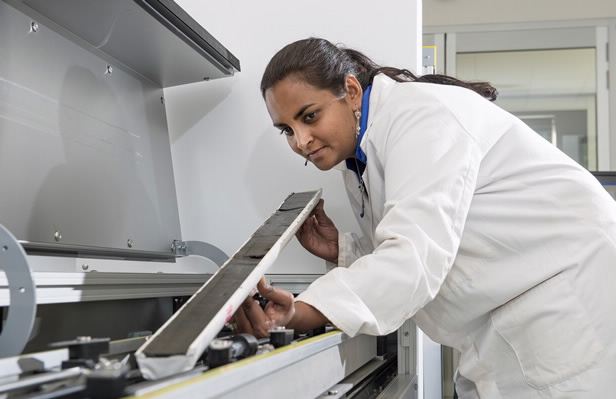The Greater Sydney Local Land Services has awarded Warringah Council more than $45,000 in grant funding to undertake a research project at Dee Why Lagoon and carry out bush regeneration in the Narrabeen Lagoon catchment.
 |
| Patricia Gadd analysing a sample on the Itrax core scanner. |
Warringah Council Environment staff will be collaborating with experts from both the Australian Nuclear Science and Technology Organisation (ANSTO) and UNSW Australia, who together will:
- Take core samples from the bed of Dee Why Lagoon;
- Analyse those samples;
- Identify the changes that have influenced the lagoon and, of those, which are natural and which are man-made; and
- Determine resulting changes in sedimentation rates.
Warringah Council Mayor, Michael Regan said, “The research will be used to shed light on past and current sedimentation rates in the lagoon and illustrate the impact catchment
development and stormwater have on the ecological condition of Warringah’s lagoons.”
The project will form part of the five year Dee Why Lagoon Management plan, whereby permanent sediment markers will be installed in Dee Why lagoon for ongoing monitoring.
“The results of the full project will show how effective our controls have been to date as well as areas that we can potentially improve on,” Mayor Regan said.
Dr Catherine Chagué-Goff, an environmental geochemist at UNSW Australia and ANSTO, and Ms Patricia Gadd from ANSTO, will analyse data obtained with a tool called the ITRAX core scanner, which is located in ANSTO’s Institute for Environmental Research.
ANSTO uses this tool and technique to take and analyse samples from all over the world – including wood, soil and lake sediments.
Scientists using the ITRAX core scanner will generate a geochemical record which gives an understanding of changes in the sample’s chemical composition, which will be overlaid with
radiometric and historical data to estimate the changes in sedimentation rates.
“Using ITRAX, we will be able to obtain extraordinarily high resolution information that can pinpoint specific environmental changes and associated variations in sedimentation rates,” Dr Chagué-Goff said.
“This technology has improved significantly in recent years - where in the past we had to estimate results based on sub-sampling, now we are in a position to get far more specific and accurate information.”
As part of the grant, more than six hectares of Oxford Creek in the Narrabeen Lagoon Catchment will undergo removal of noxious and aquatic weeds including the Bidens, Cotton Bush, Crofton, Ludwigia, Turkey Rhubarb, Morning Glory, Lantana, Privet, Bamboo, Wild tobacco, Tradescantia, Watsonia, Moth vine, Honeysuckle vine, Madeira vine, Cassia, Coral tree, Blackberry, Asparagus fern, Ginger lily, Pampas grass.
“Protecting our valuable catchments is crucial, and we will be planting 1,000 native shrubs at Oxford Creek, to enhance biodiversity, improve water quality and increase habitat for native animals in the Narrabeen Lagoon catchment,” said Mayor Regan.
ANSTO and UNSW Australia have commenced core sampling and analysis, and the work is anticipated to take a few months.


